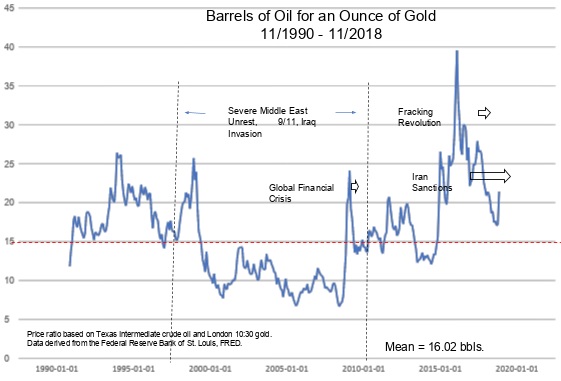With crude oil prices down 25 percent for 2018, and with major OPEC producers struggling to find ways to charge more for it, this may be a good time to examine an old relationship: oil and gold. What does it tell us about future price movements?
For years, crude oil gurus have argued that Arab oil traders think in terms of gold (not American dollars, German marks, British pounds or other currencies) when pricing their product. In short, we can forget about exchange rates and inflation risk, it’s a commodity-for-commodity market.
Those who see the oil market this way have identified a sort of golden rule. Historically, on average, an ounce of gold buys 15 barrels of crude oil.
Yes, there are ups and downs as with all actively traded markets, but after the zigs and zags are accounted for, the golden rule seems to prevail. While nothing but death and taxes are certain, when gold buys more than 15 barrels of oil for a spell, then believers predict that prices will tumble later. And vice versa. They are just not very good at saying exactly when the reversals will occur.
Consider the adjacent chart. Here I have plotted the number of barrels of oil purchased by an ounce of gold from November 1990 through November 2018. It contains a dotted line that marks the magic 15-barrel number. Notice that since 1990, the gold price of oil has oscillated around the dashed line. The average barrel count is 16 and a fraction.

I have also included some notation regarding world events that have a bearing on oil production and shipments. There was severe Middle East turmoil from 1998 through 2008, which includes the Gulf War, the September 11 attacks, and the Iraq War. During those years, the number of barrels fetched by an ounce of gold fell to a low of seven and a fraction. Then, from 2009 through 2014, things perked up to a “normal” level, when the golden rule seems to have applied.
But 2014 brought the U.S. shale oil and fracking revolution. After that, production soared and prices fell. With an ounce of gold in 2016, an oil trader could buy almost 40 barrels of oil! Since then, U.S. production has become the global oil price hobgoblin.
But as in all historic periods, oil country monarchs and dictators are again struggling to tighten production and preserve the interests of their cartels. After all, crude oil revenues are critical to the budgets of OPEC members like Algiers, Ecuador, Iran, Iraq, Libya, and Venezuela, where budget shortfalls yield political instability. Since 2016, the number of barrels fetched for an ounce of gold has headed, once again, toward the 15-barrel line.
So, what’s the forecast? Will the old golden rule once again prevail? Or has fracking technology fundamentally reset things to, say, 20 or 25 barrels for an ounce? I am of the opinion that, while 20 barrels may be the new normal for a decade or more, 15 barrels still beckons in the long run.
The reason is simple: The golden rule has survived for decades in spite of wars, plagues, revolutions, sanctions, trade wars, and tweets. It’s still tugging away, and it may pay off for us to keep an eye on it.
Bruce Yandle is a contributor to the Washington Examiner’s Beltway Confidential blog. He is a distinguished adjunct fellow with the Mercatus Center at George Mason University and dean emeritus of the Clemson University College of Business & Behavioral Science. He developed the “Bootleggers and Baptists” political model.

